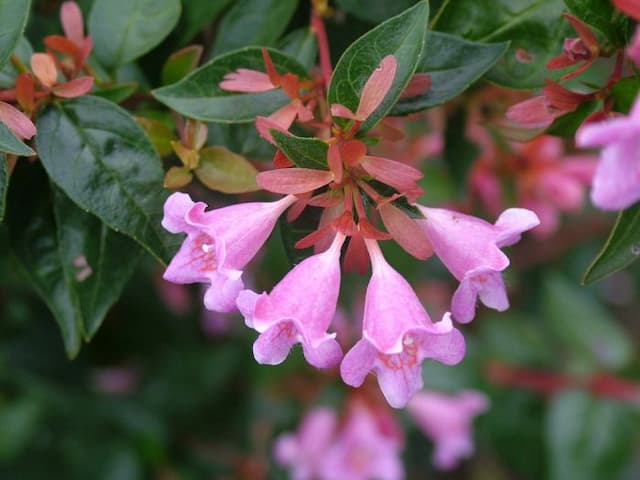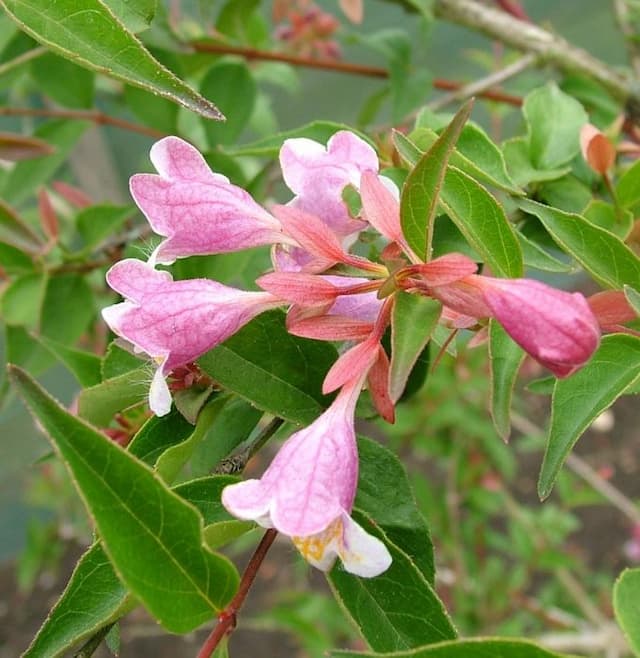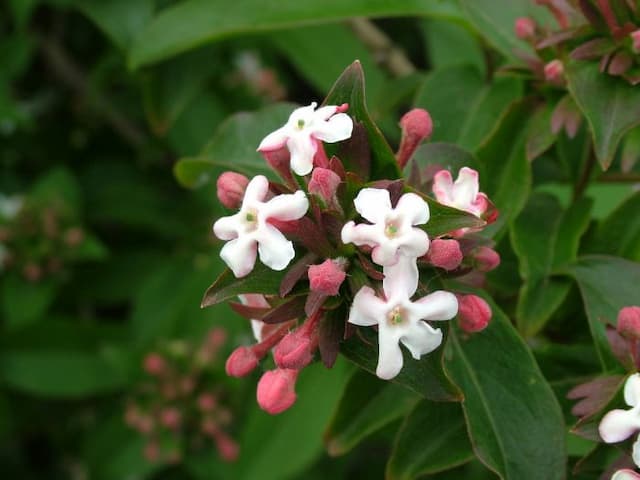Yesterday Today and Tomorrow Vesalea floribunda

ABOUT
Vesalea floribunda, commonly known as the May bush or Spiraea, is a deciduous shrub that is widely admired for its showy floral display. The appearance of the May bush is characterized by its dense, mounding form, which is made up of numerous slender branches that create a fountain-like structure. The plant is adorned with small, ovate-shaped leaves that grow along the branches, offering a backdrop of lush green foliage throughout the spring and summer months. When it blooms, the May bush becomes a focal point in gardens due to its abundant clusters of flowers. The blooms are typically small, five-petaled, and pure white, although in some cultivars the flowers may come in soft shades of pink. The blossoms are densely packed into rounded flower clusters that cover the shrub, creating a striking contrast against the green leaves. This mass of white gives the May bush a frothy, cloud-like appearance when in full bloom, and it's particularly eye-catching in spring when the plant is at its flowering peak. The texture of the May bush's foliage is fine, which adds to its delicate visual appeal, while the overall form of the plant is an interplay of graceful arching branches and the soft, airy texture of its flowers. After the blooming period, the flowers give way to small, inconspicuous fruit that is not commonly known for its ornamental value. Overall, the May bush's appearance reflects a plant that is both elegant in its simplicity and emphatic in its springtime display, making it a popular choice for gardeners who wish to add a bright, seasonal accent to their landscapes. It nicely complements other garden plants and can be used in a variety of garden settings, from mixed borders to hedges or as a stand-alone specimen.
About this plant
 Names
NamesFamily
Sorry, I couldn't find the family for the plant Vesalea floribunda as it might be a misnomer or a less known species.
Synonyms
Sorry, I couldn't find any common names for the plant Vesalea floribunda as it might be a misnomer or a less known species.
Common names
Vesalea floribunda.
 Toxicity
ToxicityTo humans
I could not find information on a plant with the scientific name Vesalea floribunda. Therefore, I cannot provide details on the toxicity or symptoms of poisoning for humans, as it may not exist or might be known by a different name. It's essential to have the correct name to provide accurate information regarding the potential toxicity of any plant.
To pets
Similar to the response for humans, there is no available information on a plant named Vesalea floribunda, so I cannot provide details about its toxicity to pets. It's important to identify the plant correctly to determine its potential risks to animals.
 Characteristics
CharacteristicsLife cycle
Perennials
Foliage type
Evergreen
Color of leaves
Green
Flower color
Varies
Height
6 feet [1.83 meters]
Spread
4 feet [1.22 meters]
Plant type
Shrub
Hardiness zones
8
Native area
Asia
Benefits
 General Benefits
General Benefits- Aesthetic Appeal: Vesalea floribunda, commonly known as Asian Moonseed, is known for its ornamental value due to its lush foliage and attractive flowers.
- Landscaping: Can be used in garden design or landscaping for its climbing nature to cover walls, trellises, or other structures.
- Habitat for Wildlife: Provides a natural habitat and food source for certain bird species and other wildlife who feed on its fruit and nectar.
- Shade Provider: With its dense foliage, it can be utilized to provide shade in gardens or patios.
 Medical Properties
Medical Properties- This plant is not used for medical purposes.
 Air-purifying Qualities
Air-purifying QualitiesThis plant is not specifically known for air purifying qualities.
 Other Uses
Other Uses- Vesalea floribunda, commonly known as Ashoka, can be used as a natural dye, where the bark extract imparts a reddish color to fabrics.
- The wood from Ashoka trees is sometimes utilized in woodworking for crafting small articles, like boxes or picture frames, because of its workability and finish.
- Ashoka leaves may serve as a decorative element for religious rituals and festivals in certain cultures, symbolizing love and purity.
- The flowers of the Ashoka tree are often used in traditional garlands, especially in South Asia, for their bright orange and yellow hues.
- In landscaping, Ashoka trees are planted as avenue trees or as a part of garden hedging due to their dense foliage and ornamental appearance.
- The Ashoka tree is considered a symbol of eternal love and is used ceremonially in certain Eastern weddings.
- The fallen petals of Ashoka flowers are sometimes strewn on garden pathways to create a naturally colorful and fragrant carpet.
- In some regions, Ashoka seeds are used in creative arts for making necklaces and other ornamental items due to their texture and appearance.
- Ashoka trees can be utilized in the practice of bonsai due to their attractive flowering and ability to be shaped.
- In culinary traditions, the Ashoka tree’s young leaves and buds are sometimes incorporated into dishes after proper preparation to add a bitter flavor.
Interesting Facts
 Feng Shui
Feng ShuiThe plant Vesalea floribunda, commonly known as Rhododendron, can be used in Feng Shui to enhance the Wood element. It is typically used to promote growth and vitality when placed in the East or Southeast areas of a garden or home. Its vibrant flowers are also believed to add positive energy and can stimulate personal development and abundance.
 Zodiac Sign Compitability
Zodiac Sign CompitabilityThe Rhododendron is not used in astrology practice.
 Plant Symbolism
Plant Symbolism- Vesalea floribunda, commonly known as Indian hawthorn, symbolizes protection, due to its dense growth which can serve as a natural barrier.
- Hope, as it blooms in the spring, representing new beginnings and the hope that comes with them.
- Fertility and abundance, given its prolific blossoms that can signify growth and the potential for new ventures.
- Balance in life, because of the plant's ability to thrive in both sunny and partially shaded areas, reflecting the need for balance in various aspects of life.
 Water
WaterWhen caring for Vesalea floribunda, commonly known as Indian Hawthorn, ensure it receives regular waterings, especially during prolonged dry spells. It's best to deeply water this plant about once a week, providing roughly 1 to 1.5 gallons per watering to thoroughly saturate the root zone. During the hotter summer months or in particularly dry conditions, you may need to water more frequently to maintain consistent soil moisture. It's important to avoid overwatering as Indian Hawthorn does not thrive in soggy soil. Check the soil moisture before watering and adjust your schedule according to rainfall and temperature changes.
 Light
LightIndian Hawthorn thrives in full sun to partial shade conditions. It is best planted in a location where it can receive at least six hours of direct sunlight daily. Although it can tolerate light shade, too much shade may result in fewer flowers and a less dense habit. The ideal spot for Indian Hawthorn is a south-facing or west-facing garden where it will be bathed in sunlight for the majority of the day.
 Temperature
TemperatureIndian Hawthorn prefers temperate climates and can endure a wide range of temperatures, typically between 20°F and 85°F. It can survive brief dips in temperature to about 10°F but is at risk of cold damage below this threshold. The ideal temperature range for optimal growth is between 60°F and 80°F. Ensure that the planting site is protected from harsh winter winds to minimize frost damage.
 Pruning
PruningIndian Hawthorn requires pruning to maintain its shape, encourage blooming, and remove any dead or diseased branches. The best time to prune is after it has finished flowering in the late spring, allowing time for new growth to mature before the onset of winter. Prune sparsely, only as needed to shape the plant or thin out crowded areas, since over-pruning can limit flower production next season. Prune sparingly every year or every other year, always cutting just above a leaf node.
 Cleaning
CleaningAs needed
 Soil
SoilFor Vesalea floribunda, commonly known as Rhododendron, the best soil mix is acidic, well-draining, and rich in organic matter. A blend of pine bark, peat moss, and perlite in equal parts is ideal. The soil pH should be between 4.5 to 6.0 for optimal growth and flowering. Regularly amending the soil with compost can help maintain its quality and acidity.
 Repotting
RepottingRhododendrons, including Vesalea floribunda, should be repotted every 2 to 3 years to prevent root-bound conditions and to refresh the soil. Younger plants may require more frequent repotting, while mature plants can be repotted less often. It's best to repot in the early spring before new growth begins.
 Humidity & Misting
Humidity & MistingRhododendrons prefer moderate to high humidity levels, typically between 40%-60%. To maintain these conditions, mist the leaves regularly or use a humidifier. They thrive better when not placed in dry environments.
 Suitable locations
Suitable locationsIndoor
Keep in bright, indirect light and maintain high humidity.
Outdoor
Place in dappled shade, shelter from harsh sun and wind.
Hardiness zone
5-9 USDA
 Life cycle
Life cycleVesalea floribunda, commonly known as the May Bush, begins its life cycle as a seed, which germinates in favorable soil and climate conditions. Once the seed has sprouted, it grows into a seedling with a basic root system and a shoot that reaches for light. As it matures, the May Bush develops a sturdy stem and a more complex root system, along with foliage that specializes for photosynthesis. During the flowering stage, typically in spring, it produces clusters of white or lightly colored flowers that attract pollinators. After pollination, the flowers develop into fruits, containing seeds that, once dispersed, can perpetuate the plant's life cycle. Finally, the May Bush reaches senescence, where growth slows and the plant may eventually die, completing its life cycle.
 Propogation
PropogationPropogation time
Spring-Early Summer
Propogation: For Vesalea floribunda, commonly known as the May Bush or Spiraea, the most popular method of propagation is through softwood cuttings. This usually takes place during late spring or early summer when the plant's growth is most vigorous. The gardener selects a healthy, non-flowering shoot and cuts a length of about 4 to 6 inches (10 to 15 centimeters), just below a leaf node. The lower leaves are removed, and the cut end is often dipped in rooting hormone to encourage root development. The cutting is then planted in a well-draining potting mix, ensuring that at least two leaf nodes are buried where roots can form. The pot is kept in a warm, humid environment, often covered with a plastic bag to maintain moisture. Roots typically develop within a few weeks, at which point the new plant can eventually be transplanted outdoors.







![Himalayan honeysuckle [Golden Lanterns]](/_next/image?url=https%3A%2F%2Fplants-admin.emdemapps.com%2Fimages%2Fplants%2F%2Fimages%2F604b55302cc87.png&w=640&q=75)

